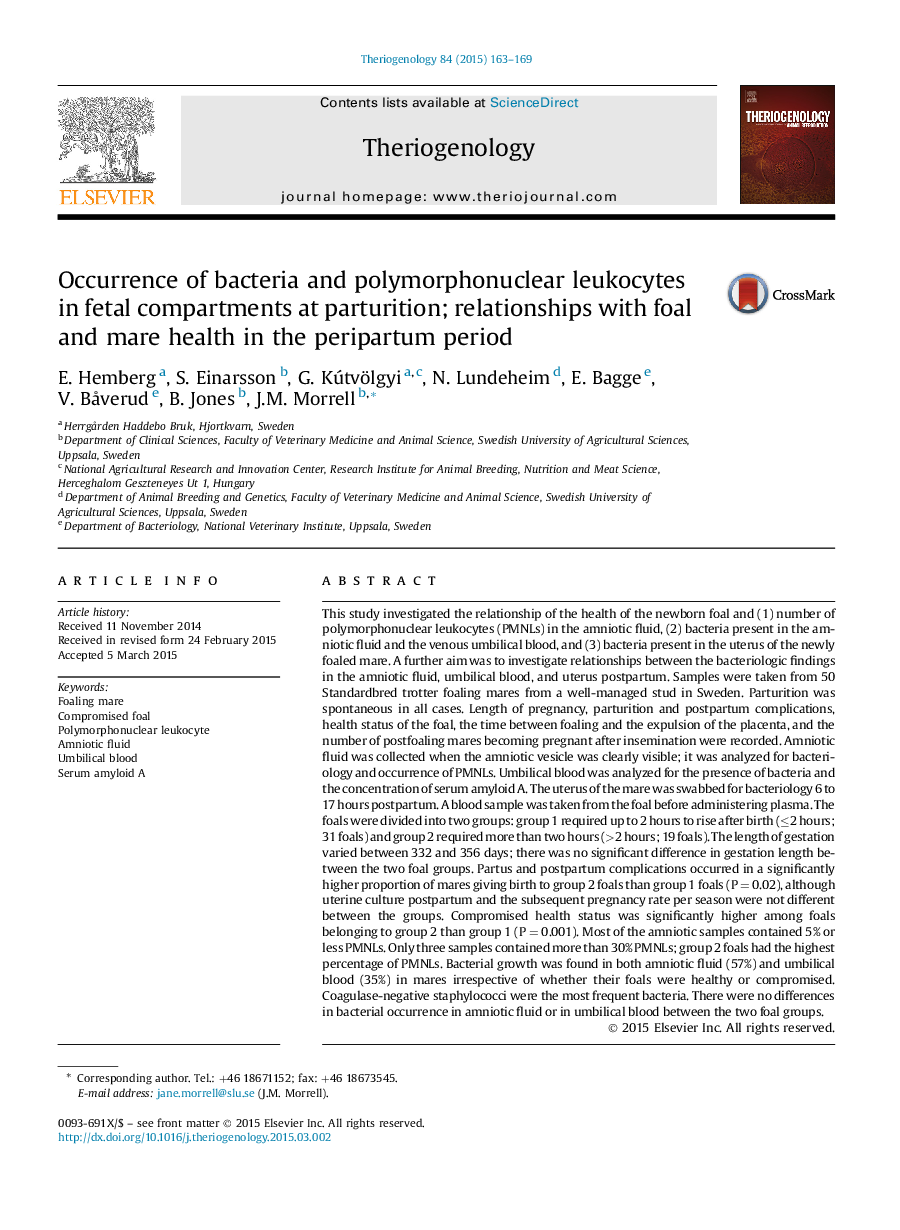| کد مقاله | کد نشریه | سال انتشار | مقاله انگلیسی | نسخه تمام متن |
|---|---|---|---|---|
| 10891760 | 1082062 | 2015 | 7 صفحه PDF | دانلود رایگان |
عنوان انگلیسی مقاله ISI
Occurrence of bacteria and polymorphonuclear leukocytes in fetal compartments at parturition; relationships with foal and mare health in the peripartum period
ترجمه فارسی عنوان
پیدایش باکتری ها و لکوسیت های پلی مورفوکلئیک در محفظه های جنینی در هنگام تولد؛ ارتباط با سلام وحشی و مرج در دوره پرپارتم
دانلود مقاله + سفارش ترجمه
دانلود مقاله ISI انگلیسی
رایگان برای ایرانیان
کلمات کلیدی
موضوعات مرتبط
علوم زیستی و بیوفناوری
علوم کشاورزی و بیولوژیک
علوم دامی و جانورشناسی
چکیده انگلیسی
This study investigated the relationship of the health of the newborn foal and (1) number of polymorphonuclear leukocytes (PMNLs) in the amniotic fluid, (2) bacteria present in the amniotic fluid and the venous umbilical blood, and (3) bacteria present in the uterus of the newly foaled mare. A further aim was to investigate relationships between the bacteriologic findings in the amniotic fluid, umbilical blood, and uterus postpartum. Samples were taken from 50 Standardbred trotter foaling mares from a well-managed stud in Sweden. Parturition was spontaneous in all cases. Length of pregnancy, parturition and postpartum complications, health status of the foal, the time between foaling and the expulsion of the placenta, and the number of postfoaling mares becoming pregnant after insemination were recorded. Amniotic fluid was collected when the amniotic vesicle was clearly visible; it was analyzed for bacteriology and occurrence of PMNLs. Umbilical blood was analyzed for the presence of bacteria and the concentration of serum amyloid A. The uterus of the mare was swabbed for bacteriology 6 to 17 hours postpartum. A blood sample was taken from the foal before administering plasma. The foals were divided into two groups: group 1 required up to 2 hours to rise after birth (â¤2 hours; 31 foals) and group 2 required more than two hours (>2 hours; 19 foals). The length of gestation varied between 332 and 356 days; there was no significant difference in gestation length between the two foal groups. Partus and postpartum complications occurred in a significantly higher proportion of mares giving birth to group 2 foals than group 1 foals (P = 0.02), although uterine culture postpartum and the subsequent pregnancy rate per season were not different between the groups. Compromised health status was significantly higher among foals belonging to group 2 than group 1 (P = 0.001). Most of the amniotic samples contained 5% or less PMNLs. Only three samples contained more than 30% PMNLs; group 2 foals had the highest percentage of PMNLs. Bacterial growth was found in both amniotic fluid (57%) and umbilical blood (35%) in mares irrespective of whether their foals were healthy or compromised. Coagulase-negative staphylococci were the most frequent bacteria. There were no differences in bacterial occurrence in amniotic fluid or in umbilical blood between the two foal groups.
ناشر
Database: Elsevier - ScienceDirect (ساینس دایرکت)
Journal: Theriogenology - Volume 84, Issue 1, 1 July 2015, Pages 163-169
Journal: Theriogenology - Volume 84, Issue 1, 1 July 2015, Pages 163-169
نویسندگان
E. Hemberg, S. Einarsson, G. Kútvölgyi, N. Lundeheim, E. Bagge, V. BÃ¥verud, B. Jones, J.M. Morrell,
